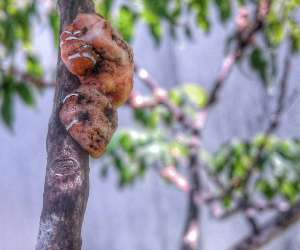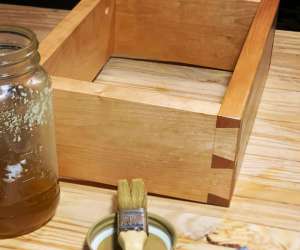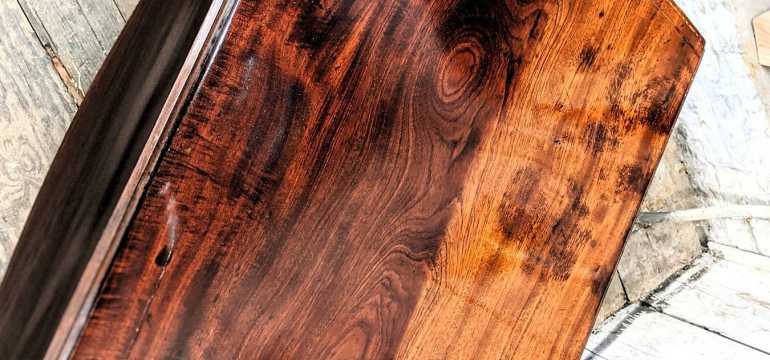If you are new to woodworking, one of the important decisions you will have to make is how to finish out your project. Wood, by itself, in its raw state, can be very susceptible to moisture, humidity, and spilled water or other liquids. If you don’t want the normal wear and tear of life to ruin your project, you need to place a protective layer of some kind between it and the world. And that protective layer, whatever form it may take, is known as the finish. Two of the more popular types of finishes are shellac and varnish.
In this guide, we will discuss the difference between shellac and varnish and suggest some ways that you may or may not want to use these specific products. When it comes to shellac vs. varnish, the key differentiating factors lie in the terminology.
Shellac vs. Varnish: Origins and Composition
 Shellac is actually an organic substance, a resin secreted by the Kerria lacca, or lac bug, which lives in the forests of India and parts of Asia. The gummy, hardened residue that the insects leave behind on tree trunks is harvested, usually in flake form, and then later dissolved in alcohol to create a compound that is typically amber-colored and translucent in nature. The color of shellac can vary from light yellow or gold to deep orange or reddish-brown.
Shellac is actually an organic substance, a resin secreted by the Kerria lacca, or lac bug, which lives in the forests of India and parts of Asia. The gummy, hardened residue that the insects leave behind on tree trunks is harvested, usually in flake form, and then later dissolved in alcohol to create a compound that is typically amber-colored and translucent in nature. The color of shellac can vary from light yellow or gold to deep orange or reddish-brown.
The word “varnish” is an umbrella term, so it does not refer to any specific product, but rather to a grouping of products or a finished effect. Varnish is not wood stain, because wood stain adds color or pigment to the wood surface and varnish does not. Varnish is clear, transparent, and often glossy.
As mentioned, the term “varnish” can encompass a wide variety of products. There is lacquer, acrylic, and polyurethane, to name just a few. Technically, shellac might be considered a type of varnish, although its organic nature and its natural hue prompt some people to place it into a category all by itself.
Shellac vs. Varnish: Drying and Curing Method
One of the features that distinguishes shellac from varnish is the way the two types of substances dry or cure. Varnish cures while it is drying. When it is done drying and curing, the completed finished surface is untouchable by solvents.
 Shellac is different, however. Shellac, when it has dried, can be softened and removed, or simply moistened, with a bit of lacquer thinner or with some alcohol. Another coat of shellac will also soften up the coat beneath it, enabling a tighter bond. Each successive coat of shellac gels with the one under it to create a more effective and impermeable surface.
Shellac is different, however. Shellac, when it has dried, can be softened and removed, or simply moistened, with a bit of lacquer thinner or with some alcohol. Another coat of shellac will also soften up the coat beneath it, enabling a tighter bond. Each successive coat of shellac gels with the one under it to create a more effective and impermeable surface.
Usually, people who are using shellac for their projects apply a number of thinner coats to gradually build up the layer of finish to the desired thickness. When it is applied to a piece of wood furniture, or to some other woodworking project, shellac provides an incomparable layer of protection.
Shellac vs. Varnish: Uses and Application
 Due to its superior curing abilities, varnish is often used for exterior surfaces as well as interior ones. Shellac, on the other hand, is usually only suitable for interior pieces, such as floors, furniture, cabinets, or decorative items. Woodworkers often employ shellac to coat antique pieces, beautiful cabinetry, or exquisite tabletops. The unique richness and glow of shellac make it the perfect protective complement for such treasured pieces. Shellac is also non-toxic compared to varnish. In fact, it is sometimes used to coat pills or to produce certain types of candies.
Due to its superior curing abilities, varnish is often used for exterior surfaces as well as interior ones. Shellac, on the other hand, is usually only suitable for interior pieces, such as floors, furniture, cabinets, or decorative items. Woodworkers often employ shellac to coat antique pieces, beautiful cabinetry, or exquisite tabletops. The unique richness and glow of shellac make it the perfect protective complement for such treasured pieces. Shellac is also non-toxic compared to varnish. In fact, it is sometimes used to coat pills or to produce certain types of candies.
When you are applying shellac, it is usually best to brush it on. It dries fast, so be sure not to leave any splotches or globs or drips on the surface. If you see such blemishes, smooth them out immediately to ensure a nice smooth final product. Some woodworkers put on the shellac with a brush and use a piece of muslin to smooth it out, working with the grain of the wood for each stroke.
Applying varnish is a very similar process, usually involving a natural bristle brush for oil-based varnish and a synthetic bristle brush for water-based varnish. Some thinner types of oil-based varnish can be rubbed on with a rag for a hand-worked look.
There are varying gloss levels of varnish available, depending on the composition of the product, so if you would rather not have a high gloss, ultra-reflective surface, you can purchase a varnish with a satin or semi-gloss sheen instead.
The Final Selection
If you are wondering whether to use shellac or varnish, think about your end goals for the project. High-traffic areas or pieces, or projects that will be used mostly outdoors, are good candidates for varnish. That includes flooring, frequently used pieces of furniture, or interior trim. As mentioned, shellac works well for beautiful heirlooms or the more showy pieces of furniture, art, or trim within your home.
- How to Cut Lexan - September 25, 2020
- Mineral Spirits vs. Mineral Oil - September 25, 2020
- Shellac vs. Polyurethane - September 24, 2020
